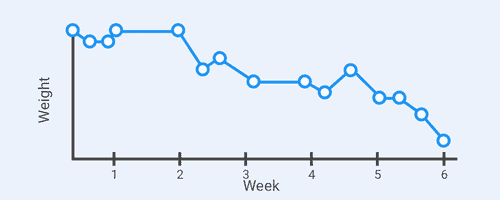How to identify—and break—a weight loss plateau

What is a weight loss plateau? | Causes | How long a weight plateau lasts | How to break a weight plateau | Break your weight loss plateau with Noom
- A weight loss plateau happens when you stop losing weight for about two weeks.
- Weight loss plateaus are frustrating, but a normal part of the weight loss process.
- You can overcome a weight loss plateau with just a handful of changes—you have to be patient, and remember everyone’s body is different.
When people set out to lose weight, they might assume the numbers on the scale will go down steadily.
In reality, it’s more common for your weight to fluctuate—you’ll go up and down. But if you’re following your program successfully, you should be able to steadily lose weight in a descending trajectory overall.

However, it’s also common to hit a weight plateau in your weight loss journey where your weight loss has stopped.
What is a weight loss plateau, exactly? And is it something you can overcome?
Noom Weight is all too familiar with the weight loss plateau.
We know it’s frustrating, but it shouldn’t deter you from sticking with your weight loss plan. We’re here to help you hit your goals, and get past the dreaded plateau. Here’s how.
Note: This article is based on our Noom Weight curriculum. Learn more below.
Ready to make a lasting change?
A healthier you, wherever you are.
What is a weight loss plateau?
A weight loss plateau is when you go two or more weeks without weight loss, even if you had previously been losing weight at a steady pace.
That’s right, when you step on the scale for 14 days straight without seeing progress, that’s a weight loss plateau.
Weight loss plateaus are frustrating, and predictably unpredictable.
Predictable because it’s going to happen (we hate to break it to you, but it is. It’s all part of the process.) Unpredictable because we never know when it’s going to happen.
When you hit a weight loss plateau, be sure to remember:
- Weight plateaus are normal.
- Weight plateaus are frustrating. (Permission to scream into a bag of romaine, granted.)
- Weight plateaus don’t mean you’re doing something wrong.
- Weight plateaus don’t mean you’re not making progress.
What causes a weight loss plateau?
A quick reminder: Your weight fluctuates daily based on how hydrated you are, how much sodium you eat, the scale you use, and so much more.
It might be easy to pinpoint why the scale didn’t budge, or even ticked up from one day to the next—like a very soy-saucy dinner at your local sushi bar.
But it’s a lot more difficult to pinpoint why you’ve hit a plateau—especially if you’re still doing all the things that have worked for you up until now. (Like staying within your calorie budget, getting your steps in, and making more mindful food choices).
Plateaus are complicated. But here’s what we do know—when you feed your body fewer calories:
- You lose weight, lowering your basal metabolic rate (BMR), which is the number of calories your body burns at rest each day.
- Your fat cells get smaller, so you produce less of the hormones that regulate hunger.
- Your body makes more of the hormones that stimulate hunger. (Cue the growling stomach.)
- You burn less during your workout. (Doesn’t make volleyball any less fun, though.)
- You think you’re eating less, which could make you more likely to overeat. (That’s where measuring cups, spoons, and food scales can help.)
- Food seems more rewarding, making large portion sizes, sugary treats, and calorie-dense eats even better.
Also, when you eat fewer calories, your body realizes that you’re consuming fewer calories.
So, it becomes more efficient at using calories, which decreases the total amount of calories your body needs in a day to perform basic functions.
This decrease in BMR, which happens in response to eating in a caloric deficit, is known as metabolic adaptation. Eating in a modest caloric deficit with the goal of losing 1 to 2 pounds per week is one way to reduce metabolic adaptation and support you in reaching your weight loss goals.
All these totally natural changes can send any of us into a woeful weight loss plateau.
So, while plateaus are definitely no fun, remember that they happen to all of us.
How long does a weight loss plateau last?
For a weight loss plateau to truly be a plateau, you need to experience it for at least 14 days. From there, it really depends on how long it lasts.
That will vary from person to person—some people might break the streak on day 15, and for others it might last a few more weeks or longer.
Ready to make a lasting change?
A healthier you, wherever you are.
How to break a weight loss plateau
We have four practical tips to help you push past your plateau:
Weight loss plateau breaker tip #1: Ride the waves
When the scale won’t budge after a couple of weeks, take a deep breath. Stay strong. And don’t change a thing.
Just be patient, and ride the waves.
Why? Just because the scale has stalled doesn’t mean you’re doing something wrong. When you’re on your weight loss journey, you’re still developing lifelong habits as you work towards achieving your goals.
Not losing weight doesn’t mean you’re not making progress, either. You’re still doing all the right things. You’re just not seeing that reflected on the scale at the moment. (Frustrating, we know.)
And most importantly, because sticking with your plan works.
Weight loss plateau breaker tip #2: Meet your calorie budget
When we hit a plateau, our first instinct is to do one of two things:
- Throw our hands in the air and eat all the food. We’re not losing weight, so we may as well find the nearest all-you-can-eat buffet, right?
- Start eating way too little.
But neither of these (totally understandable) instincts is helpful.
There’s no need to fall into the all-or-nothing thinking trap, or to skimp on food.
In fact, eating too little will only cause our bodies to hold on to that weight even tighter.
And we want to push past our plateaus, not prolong them.
Weight loss plateau breaker tip #3: Move more
Exercise makes up less than 5% of your daily calorie burn.
While other activity—all the calories you burn scrubbing your pans, chasing your nephew, and walking your dog—makes up 15% of your daily burn.
So you don’t need to buy an expensive indoor bike, train for a half marathon, or start walking with those ’80s-inspired ankle weights.
Simply make a conscious effort to move more in your daily life.
To help you boost your activity level, why not challenge yourself to walk 1,000 more steps every day?
While that seems like a lot, it’s only about 10 minutes of extra movement a day. (And you don’t even have to do it all at once.)
Some suggestions include taking a walking coffee break, getting up and pacing for two to three minutes, three to four times a day, or going for a stroll around the block after a meal.
Weight loss plateau breaker tip #4: Take a “diet” break
Here’s your permission to mix things up. Ease up on the pressure by adding some more calories to your calorie budget.
More calories?
Studies published in the International Journal of Obesity and Related Metabolic Disorders, the American Journal of Clinical Nutrition, and more show that “overfeeding”—increasing your calorie intake after a period of being in a calorie deficit—can increase feelings of being satisfied and boost calorie burn in the short term. (A silver lining? Don’t mind if we do.)
So there you have it, four practical tips to push past a plateau. You can try one or try them all. But for right now, which practical tip sounds most exciting to you?
Break your weight loss plateau with Noom
At Noom, we know weight loss plateaus can be frustrating. We also have enough experience to know that weight plateaus are a normal part of the weight loss process.
That’s why we have the tools to help you understand—and eventually break through—a weight loss plateau.
Through a science-backed curriculum to help you understand your eating habits, one-on-one coaching to keep you motivated and accountable, and a food logging system to track your progress and help you make healthier food choices each day, Noom can help you lose weight and maintain healthier eating habits long-term.
Noom offers guidance and support to help you through every part of your weight loss journey—including the ups and downs and getting past the dreaded weight plateau.

